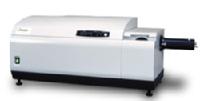Circular Dichroism (CD)
Circular dichroism (CD) is the difference in absorption of left and right circularly polarized light. CD is mainly used with solutions of chiral molecules (i.e. molecules that cannot be superposed on their mirror images), including proteins and nucleic acids.
 How does it work?
How does it work?
The essential features of a CD spectropolarimeter are: a source of (more-or-less) monochromatic left and right circularly polarized light and a means of detecting the difference in absorbance of the two polarizations of light.
The normal method of measuring CD is to implement a polarization phase-modulation technique as the signals are a small difference between large absorbances.
The most common applications of CD spectroscopy are to prove that a molecule is chiral and to probe the structure of biological macromolecules, in particular determining the secondary structure content of proteins. It is also useful for measuring the binding of molecules to a chiral molecule. Most CD applications involve randomly oriented (solution) samples.
Applications:
Biomolecule structure analysis, including DNA and RNA, protein secondary structure content, protein tertiary structure; small molecule chirality; structural variations due to environmental change.
Sample handling requirements:
Usually solutions with a maximum absorbance of 1 in the region of interest. Buffer or other matrix components should not have a significant absorbance. Typical concentrations range from 0.1–1 mg/mL for a 1 mm or 1 cm cuvette.
Complementary techniques:
Absorbance spectroscopy; Linear dichroism; Ion Mobility Mass Spectrometry; Raman Spectroscopy; XRD.
Warwick capability:
We have 6 CD machines, 3 of which will also measure linear dichroism. Jasco J-815 (with fluorescence detected spectroscopy, multiple sample holder, and temperature control), Jasco J-815, Jasco J-J720, Jasco J-600, two Biologic MOS-450 stopped flow spectrometers.
Contact:
Dr Ian Hancox, 024 76 150 577 email i dot hancox at warwick dot ac dot uk.
Professor Alison Rodger, Director, Warwick Centre for Analytical Sciences, 07920 531 213 email a dot rodger at warwick dot ac dot uk.
Status |
Availability |
 |
Book Now |
 |
Warwick collect/analyse data |
 |
Warwick collect data |
 |
Available to user with expertise/contribution |
 |
Spare capacity for collaborative research |
Typical results format, and sample:


